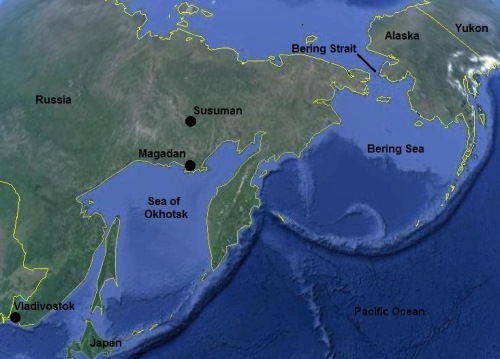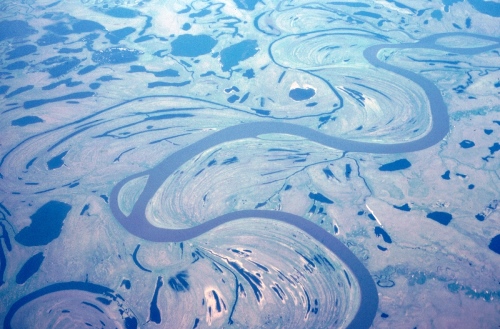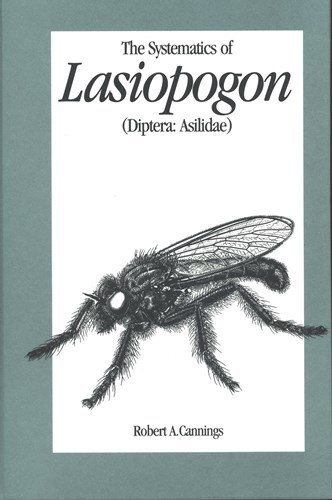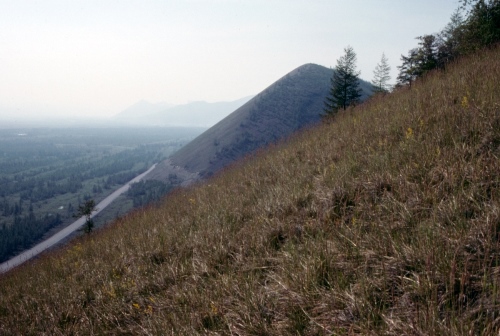In June 1993, I jetted westward from Anchorage, Alaska, across the Bering Sea (Fig. 1). As the hills of Chukotka appeared to starboard, a thrill of anticipation ran through me. This trip to Far-eastern Russia was vital to my research in insect systematics, the study of the evolutionary relationships among organisms. In particular, I was struggling to decipher the “family tree” of about 120 species of predaceous robber flies in the Northern Hemisphere genus Lasiopogon, (Fig. 2). Some species are the most northerly-living robber flies on earth. Big questions danced through my mind: How are all these species related? Where do they live? How did they get there?
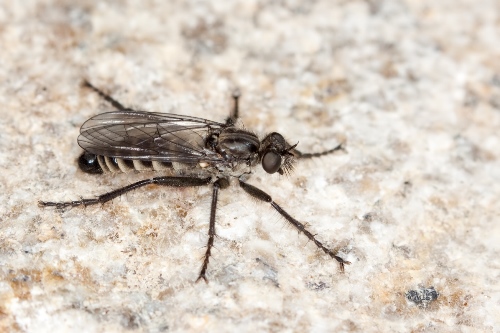
Figure 2. Lasiopogon aldrichii (male), a species of the mountains of southern of British Columbia. Photo: Werner Eigelsreiter.
Twenty thousand years ago, my arctic flight would have passed over land, not water. During the last ice age a tundra landscape hundreds of kilometers wide joined ice-free eastern Russia and northwest North America. Called Beringia, this land connection spanning thousands of years accounts for many of the striking similarities between the flora and fauna of the Old and New Worlds. Beringia connected Eurasian populations of many plants and animals with some of their North American relatives. Other closely related North American populations, severed from Beringia by huge ice sheets, evolved separately farther south. Because of this close Eurasian connection, even today many species from Alaska and the Yukon are more closely related to Russian species than they are to North American ones. Some of these are Lasiopogon species.
Little was known about the Lasiopogon flies of eastern Russia, and I desperately wanted to see them on their home ground. I had been told by colleagues in Vladivostok that to study the collections in the Institute of Biology there I would have to pay them a visit; nothing so valuable would be trusted to loans sent through the unreliable mails. With a research grant from the Friends of the RBCM and another from International Education Services at the University of Guelph, off to Vladivostok I went.
The flight was spectacular. The tundra of Anadyr (Fig. 3) gave way to the sparse larch forests of Magadan and finally to the lush deciduous woods and farms of Primorskiy Kray, the southern, Maritime Province of Far-eastern Russia. Vladivostok is the largest city of the region and is Russia’s main Pacific port, lying just east of northern Japan.
I was met at the airport by Dr. Arkady Lelej (Fig. 4), the head of the Entomology Section of the Institute of Biology and, during my visit, I stayed with him in his apartment. Fortunately for me, he spoke excellent English; my Russian is, well, hopeless. I also worked with Dr. Pavel Lehr (Fig. 4), who was the retired Director of the Institute and the expert on Eurasian robber flies. He was the scientist who had originally invited me to Vladivostok and I was one of his first foreign guests. For decades the city had been closed to travellers, even most citizens of the nation, because of its military importance. Eighteen months after the dissolution of the Soviet Union in December, 1991, Pavel Andreyevitch was an excited, delightful host. For days I examined the Institute’s collections in detail and Pavel Andreyevitch loaned me 900 specimens of Lasiopogon to carry back to Canada. These were rare and important samples, impossible to gather in any other way and included type specimens and undescribed species. (A type is an important specimen of an organism to which the scientific name of that organism is formally attached. It serves to anchor the defining features of that particular species). Pavel Andreyevich was the Asian authority on Lasiopogon and told me that he was “passing the torch” to me as a student of these flies. He generously allowed me to keep a good selection of the loaned Lasiopogon specimens for the RBCM collection and, because of this gift, the RBCM has the best collection in North America of Lasiopogon from Eastern Asia. Such collections of organisms from outside British Columbia are vital to our understanding of the evolutionary and geographical history of BC species.
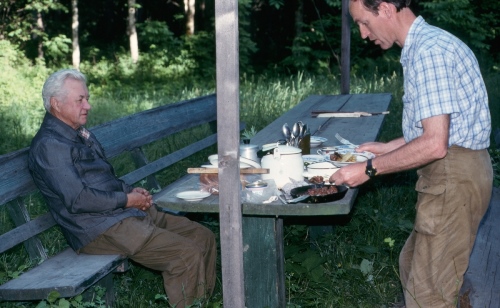
Figure 4. Pavel Lehr (left) and Arkady Lelej (right), Russian entomologists and my hosts in Vladivostok.
Later, I was happy to name a new Lasiopogon species after Pavel Andreyevich and another one after Arkady. These species are described in my book, published by the RBCM, called “The Systematics of Lasiopogon (Diptera: Asilidae)” (Fig. 5).
We explored the Vladivostok region, collecting insects at many places (Fig. 6). My favourite spot was the nearby Ussuriski Reserve, where our home was a cabin in an ancient forest of Japanese elms and Korean pines (Fig. 7). The woods rang with the calls of Oriental Cuckoos and Scaly Thrushes. The weather was glorious; we ate huge meals outside under the trees and swam in the little river that flowed nearby. I was kept busy pinning the multitudes of insects that my traps collected, and I captured my first Russian Lasiopogon specimens along a little woodland stream. I only wish that I had seen one of the few Siberian Tigers that still roam the reserve. Not even a track.
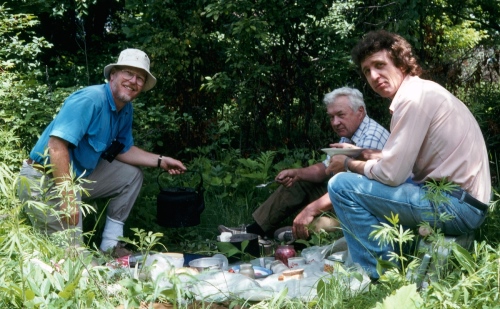
Figure 6. Tea break during collecting near Vladivostok. Me (left), Pavel Lehr (centre) and our driver (right). I’ve tucked my pant legs into my socks to help prevent tick bites. Some ticks in the region carry viral encephalitis.
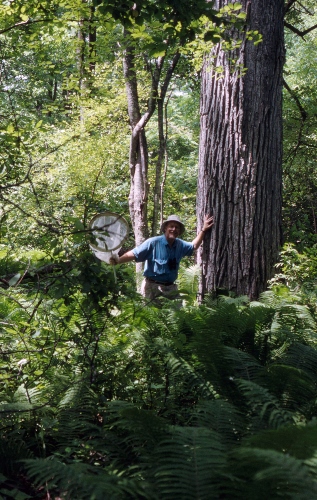
Figure 7. The beautiful forests of Ussuriski Reserve, north of Vladivostok. I’m standing among Ostrich Ferns beside a Japanese Elm.
As I had hoped, I found Lasiopogon flying on the sand bars lining the many rivers we crossed – the Khasyn, Kulu, Neruchi, and the Arga-uryach (Fig. 8). For several days we camped at Kontakt field station, deep in the subalpine larch woods (Fig. 9) where I had a one-room hut in which to prepare specimens (Fig. 10) and sleep. Here in the subarctic, many of the animals and plants were old friends from the mountains of BC and the Yukon. Rosy Finches and Northern Wheatears flew along the alpine ridges; Willow Ptarmigan and Harlequin Ducks hid along the creeks in the larch woods. White Mountain-heather and Labrador Tea blanketed the slopes. And like anywhere else in the North, the mosquitoes and horse flies were unrelenting. At Susuman I revelled in the relict steppes on the south-facing slopes of the valley (Fig. 11). These grasslands are very dry, and are the remains of a more extensive habitat that flourished in warmer times several thousand years ago. Similar places occur in the Yukon, and I wanted to compare the insects living in the two places.After two weeks in Vladivostok I flew northeast to subarctic Magadan. The flight was memorable, especially the part over the huge Amur River delta. I was a rather rare foreign passenger, and the Aeroflot crew invited me to fly (and dine) with them in the cockpit! The Magadan region’s environment is similar to that of the central and northern Yukon; a comparison of the insects on either side of the Bering Strait was one of my goals. I was the guest of the Institute of the Biological Problems of the North and Dr. Sergei Bukhalo, an insect ecologist and ground beetle expert, was my host. During eight days of my two-week stay, we nursed a battered van on a twelve hundred km marathon up the Kolymskaya Highway, a gravel road looping over the ridges and through the large valleys to the north, all the way to the Kolyma goldfields. The road was constructed in the Stalin era by forced labour and is treated as a memorial, often called the Road of Bones, because the bodies of workers who died during construction were buried under or beside it.
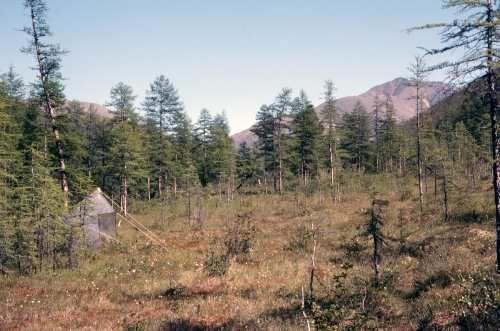
Figure 9. Malaise trap for catching flying insects in a subalpine larch forest at Kontakt Field Station north of Magadan.
What about Lasiopogon? Many of the species now living in eastern Asia are thought to have originated from populations in eastern North America (Fig. 12) as the mixed forests of the northern latitudes cooled and shrank significantly before the middle of the Miocene Epoch, about 15 million years ago. Many groups of organisms, including many genera in other fly families, show this pattern. In eastern Asia Lasiopogon evolved into several groups, including an important part of the Beringian robber fly fauna. Three Beringian species (L. hinei, L. canus, and L. prima) are closely related to Eurasian forms; they or their ancestors probably returned to North America through ice-free Beringia (Fig. 12). These flies live on the south-facing grassland slopes, in dune habitats, and along streams in the far northwest of North America. Lasiopogon hinei ranges mostly across Eurasia, and it certainly lived in Beringia when Far-eastern Russia and northwest North America were connected. Part of the population was isolated in North America after the land bridge was last flooded by rising sea-levels and, since the disappearance of continental glaciers, it has extended its range southward along the eastern flanks of the Rockies of BC into central Alberta. Specimens collected by my Russian friends in northern Japan and Sakhalin show that these island forms are darker and more bristly than the mainland flies. At first glance, they look like a different species, but detailed examination of the genitalia (Fig. 13) prove that they are the same – the changes in their outward appearance are the result of several thousands of years of geographic isolation of these islands from mainland Asia.
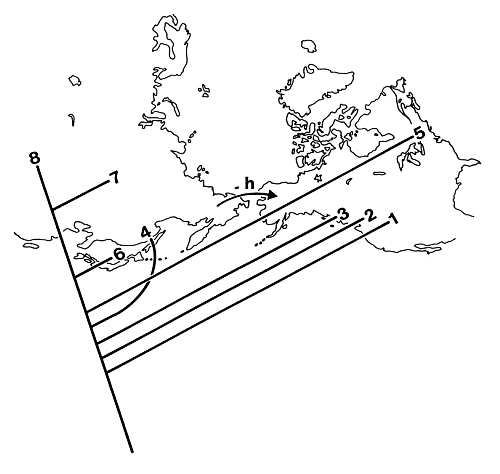
Figure 12. Evolutionary and geographical relationships of some species groups of Lasiopogon. The oldest of these groups originated in North America; younger ones now live in Asia. The arrow designated “h” represents Lasiopogon hinei recolonizing North America through Beringia.
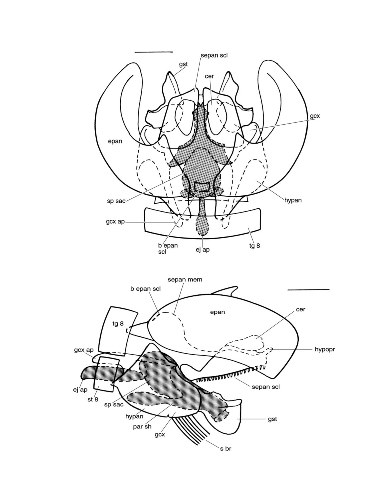
Figure 13. Illustration of the dissected male genitalia of Lasiopogon. The reproductive structures of insects provide some of the most critical information for the understanding of species evolution.
Lasiopogon prima has a similar distribution in North America to L. hinei. Since the last glaciation, from northern BC it has expanded its range to the southeast into Alberta and as far east as the Athabaska dunes of Saskatchewan. In Alaska and Yukon, it has followed tree-covered river valleys to the Arctic coast. It is the North American representative of a group of three species that is now divided by the Bering Strait. In Eurasia, from Finland east to the Kolyma River basin, its close relative, L. septentrionalis, is widespread. The other close relative lives in the grasslands of Mongolia. The species are inhabitants of northern forests and grasslands, and sister species in East and West Beringia represent a pattern that results from the separation of forest habitats in Beringia after climatic cooling in the Pliocene (about 2.5 to 5.3 million years ago) or by the first appearance of the Bering Strait itself in the Pliocene about 2.5 million years ago.
The most common Beringian Lasiopogon, L. canus, is not known yet from BC or Alberta, but is restricted to Alaska, Yukon and the northwestern Northwest Territories. This distribution is typical of a species that spent the last glaciation in eastern Beringia, then dispersed only short distances south and east after the ice melted. I am now studying and describing its closest relative, a newly discovered Lasiopogon robber fly living along rivers in central Alberta and the Peace River region of BC. Probably the ice sheets divided the original ancestral population and allowed differentiation of the two species present today. The undescribed species might have evolved in an unglaciated part of the region, or it could have spent the glacial maximum south of the ice and moved northwards following retreat of the glaciers.
A few days after returning to Magadan’s brooding sea cliffs (Fig. 14) and fogbanks, I was back on my way eastward to Alaska and the other half of the northern world. I sat back satisfied; my luggage bulged with insects to study and my mind overflowed with images of new lands discovered. I thought of the confusion, the noise, of all those Lasiopogon specimens and data gathered, and I relished the hard work to come – the joy of cutting through the mental cacophony represented by thousands of fly specimens to solve the questions of space and time rolling around in my mind at the beginning of the trip (Fig. 15). The Lasiopogon species of Beringia and Far-eastern Russia comprised only a small part of my study, but the problems involved were among the most challenging and engrossing of all.
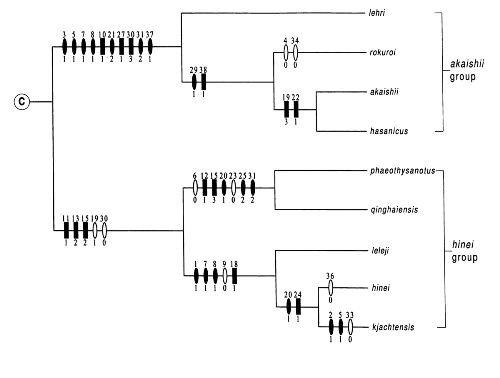
Figure 15. Cutting through the noise: an hypothesis of the relationships of some Asian Lasiopogon species.
This article first appeared in Curious Quarterly.



